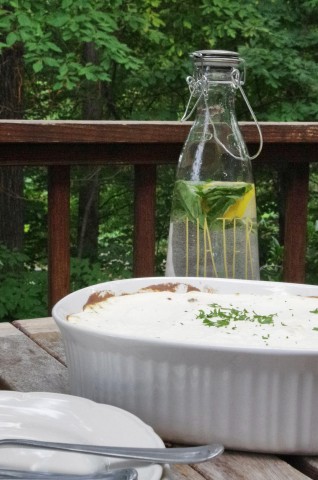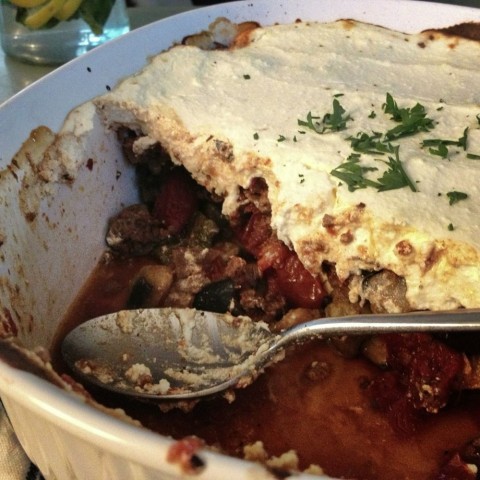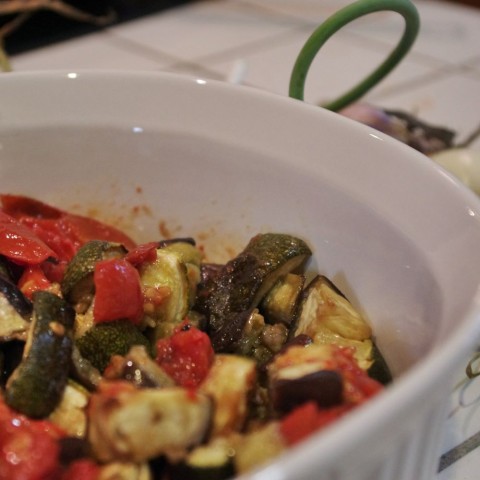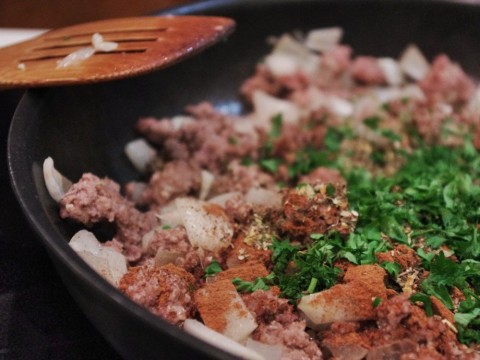In which I mostly make it up as I go
I was a great reader as a child. (Also, as one might expect, a maker of mudpies. But principally a reader.) Most of my introductions to the world came through books, and thus the first goats I met were Schwanli and Baerli, the goats kept by the Alm-Uncle in the book Heidi. They were kept for their milk. Through the lens of a novel written “for children and those who love children”, the goats seemed more like pets than livestock, and thus goats have always been to me, the most personable and most pet-like of farm animals.
So I have seldom eaten goat and I have never, until now, been able to bring myself to cook it. But as goat milk products have become more common, the idea of goat-consumption has grown more familiar too. And there it was this summer at my neighborhood farmers’ market, a locally-raised, healthier and more humane alternative to the slabs of sirloin in the supermarket. What is the easiest way to begin with goat? I asked the bearded young man behind the folding table. I was envisioning the rich stews and spicy tagines in which I’d been served goat before; surely it was cut into chunks, often still boned. But “goat chunks” was not one of the options on his chalkboard menu.
Well, he said. Well. I have chops, but most people begin with the ground, I think.
Ground goat?
Ground goat.
What does one DO with ground goat?
Well, he said, more hesitantly still. Burgers.
My skepticism must have been evident.
I mean, I don’t eat it myself, he added hastily. But burgers seem to be… the easiest… His words trailed off.
Now, I do not even like hamburgers. (They’re so big and meaty. I know, I know: you’re wondering what is wrong with me.) I have never liked hamburgers. So how could I resist such a challenge? Surely I could come up with something preferable to goat burgers!
And in time, I did. The meat languished in my freezer for a few weeks, until a happy accident suggested a use to me. Over the weekend, I’d had occasion to cube and roast some summer vegetables, and as one does, I’d taken the opportunity to roast some extra: eggplant, zucchini, and a moderate quantity of various home-grown tomatoes were all chopped and roasted, awaiting inspiration.
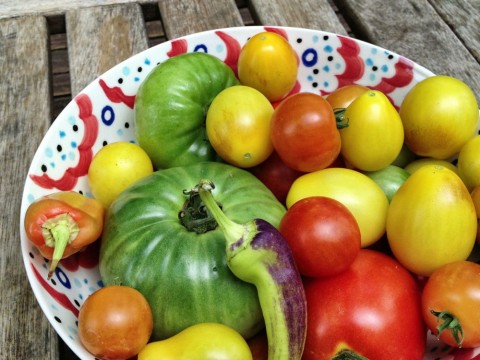 Goat. Eggplant. Tomato. Moussaka.
Goat. Eggplant. Tomato. Moussaka.
I can’t say there was a line of thought involved: it was pure inspiration.
I have not made many moussakas, but I knew I wanted to do two things differently (three, I suppose, if you include the goat). Firstly, I wanted to begin with roasted vegetables instead of raw eggplant; secondly, I wanted to substitute something simpler for the béchamel. Ricotta seemed the likeliest choice. And I needed some advice about spices. So I Googled for “roasted eggplant ricotta moussaka”; the first hit was Martha Stewart’s “Quick Moussaka Recipe”. From it I took the seasoning measurements, the feta cheese, and some measure of confidence that I was on the right track, as there is a substantial, if coincidental, convergence of method.
Roasting the vegetables ahead of time made this recipe very efficient for me. Tempting as it is to eat the roasted eggplant straight off the tray, I knew even then that I wanted to use it in another application. If you roast the vegetables on the same day you make the moussaka, you will add considerably to the preparation time. I pulled my vegetables out of the refrigerator, put them cold into a casserole dish and put the dish into a cold oven, and let it all heat up while I made the meat sauce. Once I’d tipped the hot meat sauce over the hot vegetables, it was a small matter to turn on the broiler while I mixed up the cheese topping.
The dish would have been more attractive if we’d let it brown longer, but we could Baerli wait. It was a lovely casserole: varied in texture and flavor, delightfully gamy with goat, fresh-tasting and filling, luxuriously rich-seeming but not heavy. And just like that, I have finally relinquished my reluctance to cook with goat. If I’m not quite up to chops, at least I am filled with ideas for ground goat: lemony goat meatballs, goat sausage, goat shepherd’s pie, goat in curry, Schwanli with butternut squash…
2 Medium-Large Japanese Eggplants (or the equivalent of your choice)
1 Large Zucchini
Several Tomatoes
2-3 Cooking Onions
2-3 Cloves of Garlic
1 pound Ground Goat
2/3 cup Roasted Tomato Sauce (or the stewed/tinned/sun-dried/concentrated tomato products of your choice)
1 tsp Cinnamon
2 tsp Dried Oregano
Fresh Parsley
1 Large Egg
1 1/2 cups Ricotta Cheese
3/4 cup Feta Cheese
Preheat the oven to 400F. Chop the eggplants, zucchini, and tomatoes into a large dice. It is not necessary to salt and drain the eggplants. Toss with olive oil and salt to taste, and arrange them on separate baking sheets. Roast for ten minutes, stir, and roast another ten minutes. After this, check every five minutes and remove the vegetables in turn from the oven when they are soft and starting to caramelize. They may roast at different rates (hence the separate trays).
At this stage, you may cool the vegetables and put them away for later use; if you do so, you will want to warm them in the oven, in the casserole dish, before proceeding with the recipe.
While the vegetables are either roasting or warming, make the meat sauce. Heat a tablespoon of olive oil in a large skillet on medium heat. Chop the onions roughly and add them to the skillet when hot. Mince the garlic cloves and add them. As soon as the onions begin to soften, add the ground goat. Salt and pepper lightly. Stir occasionally, breaking up any clumps, as the goat browns. When it is no longer pink, add the tomato sauce or tomatoes and tomato paste. You want just enough tomato – in whatever form – to create a thick sauce in the skillet. Add one generous teaspoon of cinnamon and two teaspoons of oregano; salt and pepper to taste. Simmer for five minutes or so, until the flavors have blended and the onions, garlic, and goat are well-cooked. I like to stir in the minced fresh parsley last, reserving some for later.
When the vegetables are done roasting, tip them into a casserole dish or Dutch oven. In due course, top with the meat sauce. Both of these layers should be hot, and you should turn your oven up to broil.
Whisk the egg in a good-sized bowl. Whisk in the ricotta; pepper it if you wish, but don’t salt. Stir in the feta cheese, breaking up any large clumps. Pour the cheese sauce over the meat.
Broil for 10-15 minutes, until it begins to get nicely browned in spots. If you want it to look pretty, sprinkle a bit of reserved fresh parsley on top.
We ate it plain and licked the serving spoon, but a green salad and a loaf of crusty buttered bread would not have gone amiss.
